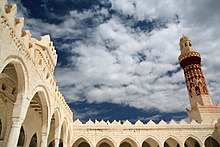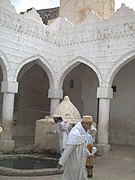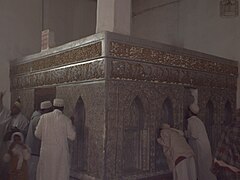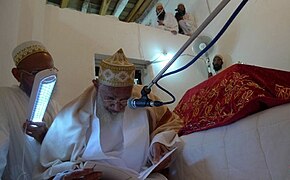Queen Arwa Mosque
| Queen Arwa Mosque Mosque of Queen Arwa bint Ahmad al-Sulayhi | |
|---|---|
| |
 View of a minaret, as seen from the courtyard | |
| Religion | |
| Affiliation | Islam |
| District | Jiblah |
| Province | Ibb Governorate |
| Region | South Arabia |
| Status | Active |
| Location | |
| Location | Jiblah |
| Cercle | Jiblah |
| Country | |
| Geographic coordinates | 13°55′19.5″N 44°08′45.4″E / 13.922083°N 44.145944°E |
| Architecture | |
| Type | Mosque |
| Style | Islamic |
| Completed | 1111 C.E. (532 A.H.) 1358 C.E. (renovation) |
| Specifications | |
| Dome(s) | 2 |
| Minaret(s) | 2 |
The Mosque of Queen Arwa bint Ahmad Al-Sulayhi (
History
The construction of the mosque is attributed to Queen Arwa bint Ahmad al-Sulayhi, who ruled the
Architecture
The complex is rectangular with an open courtyard (17.80 m2 × 20.00 m2 (191.6 sq ft × 215.3 sq ft)) in the middle, surrounded by four corridors. The wall of the qiblah is located at the northern hallway. The area of the qiblah is accessible through five entrances on the southern side. It consists of four rows of high columns, some octagonal and some rectangular shaped. The roof is directly covered by the ceiling and the hall is covered with wooden beams dating back to the 11th-century, some of which were renewed in 1358. The southern hallway consists of southern wall with two entrances. The eastern hallway consists of two pillars with pointed columns. On the south-side of the western hallway there is a hall currently used as a madrasa for the memorization of the Quran.[citation needed]
-
Courtyard
-
Carved historical entrance
-
Wooden ceiling
-
Continuous running water at the mosque
-
Minbar
Mihrab

The
Minarets
The mosque has two minarets, one located on south-east, and another on south-west. The eastern minaret consists of a high square stone based body with sixteen ribs.[citation needed]
-
Both of the mosque's minarets, as seen from below
-
View from the entrance, January 1970
-
As seen from the Palace of Queen Arwa
-
View of the mosque, nestled in the buildings of Jibla and slopes of the Sarat Mountains, as seen from the palace
Mausoleum of the Queen
It was built as ordered by the queen and is located on the north-west corner of the mosque. The site of her tomb was separated from the building of the mosque as she mentioned in her will and told by eyewitnesses and judges. The facade of the mausoleum is adorned with architectural elements, in the form of hollow niches in the eastern wall. Out of four entrances, there are two in the south which have width of 60 cm (24 in), height of 1.60 metres (5.2 feet) and depth of 10 cm (3.9 in). The kufic line is engraved with a prominent kufic floral engraving design and
-
Wooden tasbih of Hurrat-ul-Malikah
-
Mausoleum of the Queen inside the Mosque
-
The Queen's grave
See also
References
- ^ Muhammad Zakaria (1998) مساجد اليمن
- ^ ISBN 978-0-19-579868-5
- ^ Jibla and its surroundings, UNESCO World Heritage Centre, retrieved 2009-04-20
- ^ "Yemen" (PDF) (in Arabic). NIC.

















